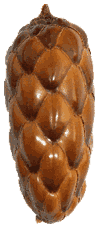 |
Palm |
 |
Palm |
Daemonorops unijuga occurs near Kampung Belimbing, in Kuching District, Sarawak, East Malaysia. It grows on steep karst limestone hills at an elevation of about 150 m above sea level. There are no estimates of population size, but the palm is very rare in its only locality
It is a slender climbing palm (rattan). Stems are clustering and reach into the forest canopy to lengths of about 20 m. The sheathed stem is about 9 mm in diameter and with the sheaths removed about 5 mm diameter; internodes are about 18 cm long. The leaf sheaths are green and covered with minute triangular, black, easily detached spines. The leaf carries just two leaflets, one on each side of the rachis; they are approximately 35 cm long and 7 cm wide; there us a short petiole and the leaf rachis ends in a long climbing whip (cirrus) to 60 cm long. Male and female inflorescences are borne on separate plants and are superficially similar; they rarely exceed 55 cm long, and are borne on the leaf sheaths and hang down from the stem. There are several sword-shaped bracts which fall as the flowers open. The greenish brown obpyriform fruit is unusually large, to 30×20 mm, covered in 17 vertical rows of reflexed scales. As in all species of the genus, the endosperm is homogeneous. This is the only species in the genus to have a leaf with just two leaflets.
The palm is dioecious, but otherwise little is known about its natural history.
The forest on karst limestone in Sarawak is almost never logged due to its extreme inaccessibility. However, in recent years the remaining islands of forest on karst limestone hills, particularly on the smaller hills, have become very vulnerable to fire, either spreading from cut secondary forest nearby or being started by lightning. The forest on several of the hills near Kampung Belimbing has already been destroyed.
There are no current conservation measures.
Last recorded in the 1980s, Daemonorops unijuga should be searched for at its type locality to confirm that it still survives there and should also be searched for on other limestone hills in Kuching District. Once relocated, a demographic study of the palm should be performed.
Dr. John Dransfield, Herbarium, Royal Botanic Gardens Kew, Richmond, Surrey, TW9 3AE, UK
Dransfield, J. 1992.
The rattans of Sarawak.
Royal Botanic Gardens Kew and Sarawak Forest Department.
Dransfield, J. and M. Patel. 2005.
Rattans of Borneo: an interactive key.
Royal Botanic Fardens, Kew.